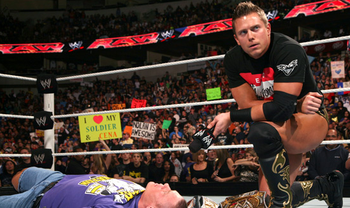| Sportswomen have not only to get past traditional prejudices but also have to overcome commercial pressures to make themselves more attractive and marketable… |
Photo: R. Ragu

GIVE THEM THE CHOICE OF DRESS: Jwala Gutta (left) and Ashwini Ponappa in action.
When a 15-year-old girl from Nizamabad in Andhra Pradesh comes back with a gold medal for, of all sports, boxing, there must be reason to celebrate. In a week dominated with grim news from around the world, the success of young Nikhat Zareen in the Junior World Championships in Antalya, Turkey in the 50 kg category of boxing was like a welcome ray of sunshine.
Nikhat's story, like that of the other three women boxers from India who also won gold, is remarkable for a number of reasons. All of them — besides Nikhat there is Sarjubala Devi from Manipur, Lalenkawli from Mizoram and Minu Basmataray from Assam — have chosen to excel in a sport that is considered “unwomanly”. All of them come from modest backgrounds without the monetary backing to pursue an individual sport of any kind, leave alone boxing. Lalenkawli's parents, for instance, are farmers and she had to travel 300 km to the only training centre in Mizoram's capital, Aizawl. The others also have similar stories.
Relatively lucky
Nikhat is lucky in that her father, Jameel, is a former state-level football player and understands the pull of sports. Neither he, nor his wife Parveen, stood in Nikhat's way when, at the age of 12, she announced that she wanted to box. Her role models were two male cousins who were boxers. She was the only girl who wanted to pursue boxing. Luckily, her uncle, who was training his sons agreed to teach Nikhat. So Nikhat learned to box with the boys. On June 14 she turns 15. In the span of three short years, she has already made a name for herself.
“As a Muslim girl, it was a tough choice to make as everyone questioned what I was doing in the boxing ring,” Nikhat told a journalist. “There were almost no female boxers where I trained in Hyderabad, and I was often alienated.” But she got past this and now joins a remarkable group of Indian women boxers led by the redoubtable Mary Kom from Manipur.
Multiple obstacles
Nikhat's success throws light once again on the vexed issue of women and sports in India. It continues to be an arena of considerable neglect. Sportswomen in this country face an incredibly hard time getting past traditional prejudices about women playing sport. If they succeed, they enter a world dominated by games that men play. Women's sports receives little attention by the media or by the sports authorities compared to the money and time invested in the men. Things change if some women like Nikhat, or the women's hockey team, come back with medals from international fixtures. Fleetingly, they hog the media spotlight. But even before we get to know their names and faces, the focus turns back to the dominant sports. Between tournaments, the women go back to their jobs, usually in institutions like the Railways, and work away until the next big tournament.
Despite all this, it is remarkable that an increasing number of women are making a name for themselves in sports. Women like Saina Nehwal, who has become the face of women's badminton alongside the equally accomplished Jwala Gutta and Ashwini Ponappa. But Nikhat is more fortunate than these women in some ways. No one is telling her, yet, what she should wear when boxing. Women badminton players, on the hand, have been slapped with a “skirts only” rule by the men who head the Badminton World Federation (BWF). Why a compulsory dress code only for women players? The BWF, apparently, decided on this course following advice from the sports marketing giant, Octagon. They wanted to make the women's game more “attractive” and “marketable”.
In other words, the BWF wants women badminton players to look more attractive on court. This, they believe, will draw more eyeballs to the game. What about their skills as players? It would appear that does not matter as long as they catch the male gaze. It seems incredible that someone can seriously contemplate such a rule, and that too for these reasons.
Different reactions Predictably, many women players have raised strong objections. As a result, the rule has been deferred by a month. Britain's leading mixed doubles player, Imogen Bankier has said, “I will fight to make sure this dated and simply sexist rule does not happen.” Several players from different countries have said that skirts will come in the way when they play and they prefer shorts. The Indian girls have not been so forthright. While Saina has said it was not an issue, Jwala has emphasised that they should be given the choice whether to wear skirts or not.
But what is really troubling about the decision is the blatant effort to use women's bodies to sell the game. And for this, the cue has been taken from women's tennis, where glamour has played a big role in drawing an audience. But there is a big difference. The Women's Tennis Association (WTA) is managed independently and women players have a say in its decisions. Thus, what women wear is decided by women players and not imposed by a male club. If women tennis players choose to be seen as fashion statements, it is their choice. But it has not diminished the power of their game. Maria Sharapova might look like a model but no one can question her skill as a player. Ditto Venus Williams. While those like Anna Kournikova, who drew attention only for their looks, have fallen by the wayside because their game was not up to the mark. People come to watch good tennis, not to gawk at women players who are fashion statements.
It is tragic that at a time when more opportunities are opening up for women, they are told they must “sell” themselves, make themselves “marketable” if they want to get financial backing for their chosen sport. Men too face the pressure of finding sponsors. But they are not asked to dress in a way that shows off their well-toned bodies and attracts female fans. While it is true that there are both men and women who go to watch football, cricket or tennis matches because they find the players good-looking, surely they will not persist unless they also enjoy the game.
As the lines between commerce, entertainment and sports disappear, young women wanting to make a career in sports face tough choices. If they don't have money, they can't train the way they need to succeed. But if they concentrate on looking presentable and finding endorsements, they are likely to be dismissed as being non-serious and in it only for the glamour. The bottom-line, however, is that those who manage a sport must respect sportswomen and give them the freedom to choose how much they bend to these commercial demands. It is unacceptable that a group of men decide how they should dress on court for no other reason than to make them “marketable”.


















